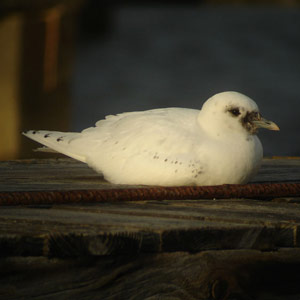Magazine | Analyses
Afflux inhabituel de Mouettes blanches en janvier 2009

Mouette blanche (Pagophila eburnea) H1, cale de Couach, port de Larros, Gujan-Mestras (Gironde), le 09/02/2009.Photographie : François Duchenne
Introduction
Décidemment, on se rappellera en Europe de l’Ouest et en Amérique du Nord de l’hiver 2008-2009 comme étant celui des espèces du Haut-Arctique : après l’arrivée exceptionnelle de Harfangs des neiges en décembre, voici qu’un nombre inhabituel de Mouettes blanches (Pagophila eburnea) a été noté depuis la mi-janvier 2009 au sud de l’aire d’hivernage normale de l’espèce, au sud-est du Canada, au nord-est des Etats-Unis et en Europe de l’Ouest. En France, un oiseau de premier hiver a été découvert sur la côte atlantique le 21 janvier, ce qui constitue un réel évènement ornithologique (il n’y avait que trois mentions dans le pays jusqu’en 1997).
Cet article sera l’occasion de présenter cette espèce très peu connue, dont la biologie soulève encore de nombreuses questions, et d’évoquer l’afflux inhabituel de ce mois de janvier 2009.
Abstract
The Ivory Gull (Pagophila eburnea) is one of the most sought-after gulls by birdwatchers as it also one of the least often seen. Small and white-plumaged, it has a black eye, black legs, and a two-toned black-and-yellow bill; immatures have small amounts of black spotting or streaking, including a narrow band on the end of the tail.
The Ivory Gull breeds right around the northern hemisphere but rarely ventures south of the Arctic Circle, nesting on boulder fields and rocky cliffs inland from the frozen sea and wintering mostly on pack ice. It is an uncommon bird, and it has a patchy distribution around the high Arctic. Its total population is estimated at 12,000-14,000 pairs and possibly stable overall with locally severe declines.
It appears a bit of an invasion of Ivory Gulls is occurring during this month of January 2009 south of the normal wintering range of the species, with for example 40 birds in Newfoundland/Labrador, 2 birds in Massachusetts, 1 bird in Iceland, one in Great-Britain and one in France.
We present you this gull, one of the least known seabird in the World, and the unusual « invasion » of January 2009.
Poursuivez la lecture de cet article, en vous abonnant dès maintenant !
Découvrez les Archives d’Ornithomedia.com
Pour seulement 10,00 €TTC/an (ou 6,00 € les 6 mois)
Profitez de plusieurs centaines d’articles en accès illimité et sans aucun engagement.
Compléments
À lire aussi sur Ornithomedia.com
À lire sur le web
La galerie de photos de Jeremiah Trimble : http://www.flickr.com/photos/jrtrimble/sets/72157612729859382/
Ouvrage recommandé
Gulls of Europe Asia and N America de Klaus Malling Olsen
Sources
- www.shetlandtimes.co.uk/
- www.birdweb.org/
- www.absc.usgs.gov/
- www.capecodonline.com
- http://tpirro.blogspot.com/
- http://birding.typepad.com
- http://web1.audubon.org/
- www.surfbirds.com/Rarities/blastfrompast.html
- K. M. Kovacs et C. Lydersen, « Birds and Mammals of Svalbard »
- Tony Soper « The Arctic a guide to coastal wildlife »
- Le Norsk-Polarinstitut: http://npweb.npolar.no/english/arter/ismake
- www.unep-wcmc.org/
- www.boston.com/
- www.cbc.ca/news/
- Évaluation et Rapport de situation du COSEPAC sur la Mouette blanche Pagophila eburnea au Canada (www.cosepac.gc.ca)





Aucun commentaire sur ce sujet
Participer à la discussion !